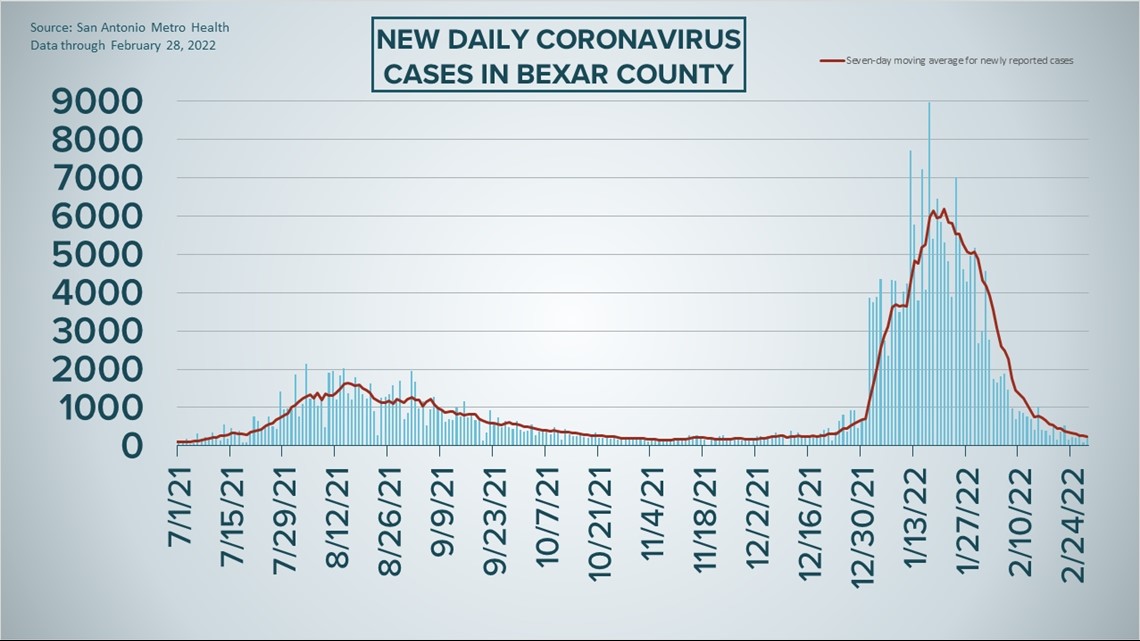SAN ANTONIO — Bexar County is waving goodbye to February with a much brighter COVID-19 outlook than it ended January with, following the dramatic surge in cases to start of 2022.
The community saw an average of 935 new daily infections in February compared to an average of 4,771 the month before, when the highly contagious omicron variant wreaked havoc in San Antonio and across the country. Metro Health reported 257 new diagnoses on Monday to close out the month, raising the county's pandemic total to past 523,000 while bringing the seven-day case average down to 251—its lowest levels since a week before Christmas.
A total of 347 infections were reported over the weekend, including a new 2022 low of 86 on Sunday.
Hospitalizations also fell in each of February's last 21 days, dropping to 318 local coronavirus patients on Monday. The number has decreased by 34% over the last week, and by 74% over the last month.
Of those 318 Bexar County patients, 74 are in intensive care and 41 are on ventilators.
While case numbers dropped and the hospital situation was increasingly less dire in February (though the county's warning indicators still say health care facilities remain highly stressed), the month did prove to be deadlier. Health authorities reported 167 deaths from COVID-19 complications in February – including 11 more to close out the month – compared to just 121 in January. In all, 5,263 county residents have died from virus complications.
As the community prepares to enter March, Metro Health's risk indicator for COVID-19 spread in the community stands at the middle "moderate" threshold, with officials saying the outlook is "improving."
How Bexar County is trending




Vaccine Progress in Bexar County
The following numbers are provided by San Antonio Metro Health. A full breakdown can be found here.
- 1.747 million eligible Bexar County residents have received at least one dose of the coronavirus vaccine as of Thursday, Feb. 24.
- 1.424 million eligible Bexar County residents are fully vaccinated as of Thursday, Feb. 24.
The CDC states that "when a high percentage of the community is immune to a disease (through vaccination and/or prior illness)," that community will have reached herd immunity, "making the spread of this disease from person to person unlikely."
The City of San Antonio breaks down the vaccination rates by zip code on Metro Health's Vaccination Statistics page.
Coronavirus in Texas
The total number of coronavirus cases in the state since the pandemic began grew by 2,950 on Monday, according to the Texas Department of State Health Services. That total includes 2,227 new confirmed cases and 723 new probable cases. More details can be found on this page.
Monday's figures bring the total number of Texans diagnosed with COVID-19 to more than 6.549 million.
An additional 33 Texans have died from virus complications, meanwhile, raising the statewide death toll to 83,549.
Coronavirus symptoms
The symptoms of coronavirus can be similar to the flu or a bad cold. Symptoms include fever or chills, cough, shortness of breath or difficulty breathing, fatigue, muscle or body aches, headache, new loss of taste or smell sore throat, congestion or runny nose, nausea or vomiting, and diarrhea, according to the Centers for Disease Control.
Most healthy people will have mild symptoms. A study of more than 72,000 patients by the Centers for Disease Control in China showed 80 percent of the cases there were mild.
But infections can cause pneumonia, severe acute respiratory syndrome, kidney failure, and even death, according to the World Health Organization. Older people with underlying health conditions are most at risk.
Experts determined there was consistent evidence these conditions increase a person's risk, regardless of age:
- Chronic kidney disease
- COPD (chronic obstructive pulmonary disease)
- Obesity (BMI of 30 or higher)
- Immunocompromised state (weakened immune system) from solid organ transplant
- Serious heart conditions, such as heart failure, coronary artery disease, or cardiomyopathies
- Sickle cell disease
- Type 2 diabetes
- The CDC believes symptoms may appear anywhere from two to 14 days after being exposed.
Human coronaviruses are usually spread...
- Between people who are in close contact with one another (within about 6 feet).
- Through respiratory droplets produced when an infected person coughs, sneezes or talks. These droplets can land in the mouths or noses of people who are nearby or possibly be inhaled into the lungs.
- Some recent studies have suggested that COVID-19 may be spread by people who are not showing symptoms.
Help stop the spread of coronavirus
- Stay home when you are sick.
- Eat and sleep separately from your family members
- Use different utensils and dishes
- Cover your cough or sneeze with your arm, not your hand.
- If you use a tissue, throw it in the trash.
Find a Testing Location
City officials recommend getting a COVID-19 test if you experience fever or chills, cough, shortness of breath or difficulty breathing, fatigue, muscle or body aches, headache, new loss of taste or smell, sore throat, congestion or runny nose, nausea or vomiting, or diarrhea.
Here's a Testing Sites Locator to help you find the testing location closest to you in San Antonio.
Latest Coronavirus Headlines
- CDC still recommends masking indoors in San Antonio, despite relaxed guidance
- Target eliminates face mask requirement for employees and shoppers
- No, hospitals don’t get more money when they list COVID-19 as a patient’s cause of death
- Why could the pandemic cause brain inflammation in people who never got COVID?
- Is omicron leading us closer to herd immunity against COVID?
- CDC eases mask guidelines for more than 70% of Americans
- Experiencing long COVID symptoms? Here's what you need to know.
- Nearly half of Biden's 500 million free COVID tests still unclaimed

